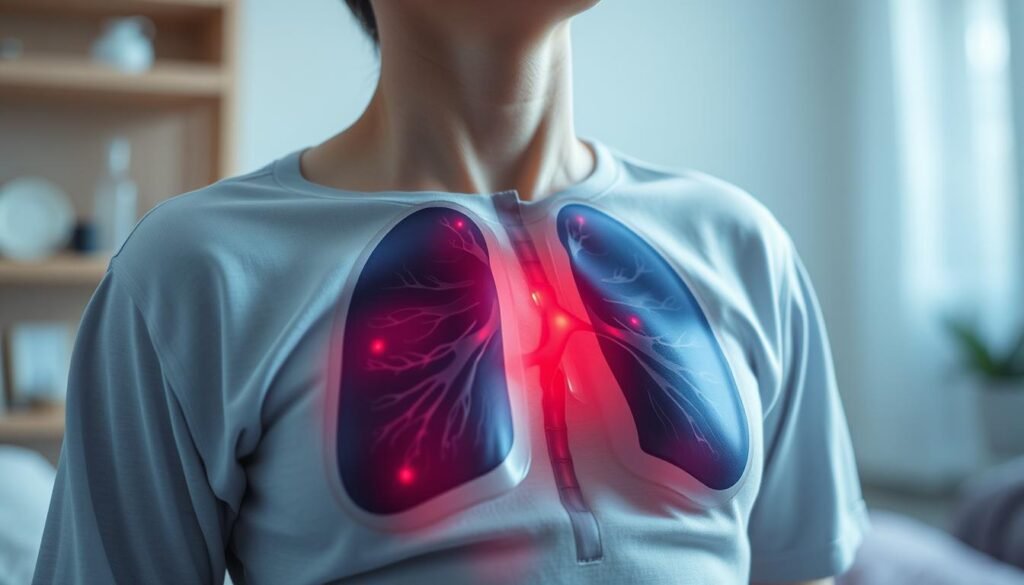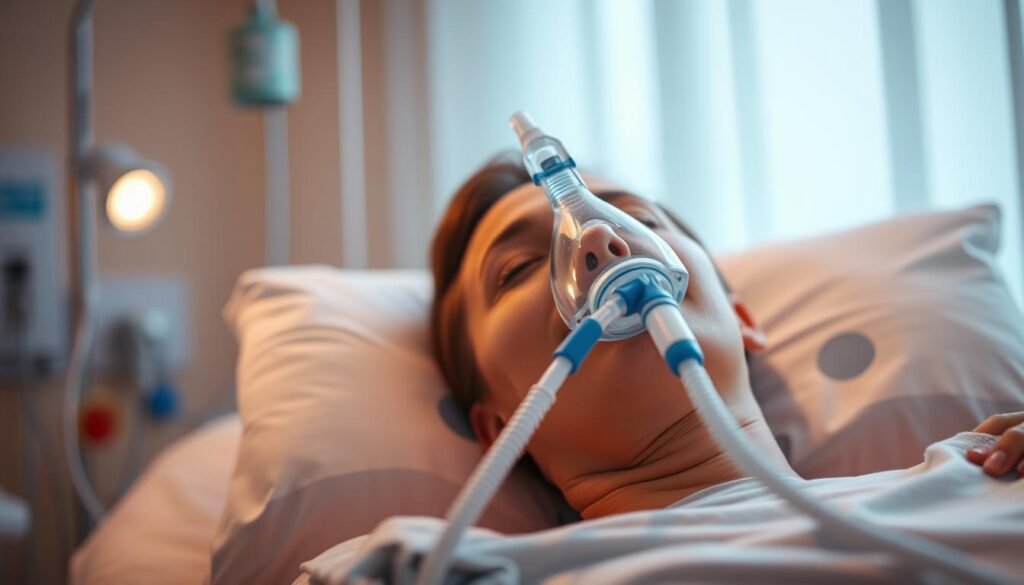What if the very medication meant to help could actually put your life at risk?
Respiratory depression is a serious health issue. It’s marked by shallow or slow breathing. This can lead to not enough oxygen in the body and cause big problems. It can come from various places, like certain meds, opioids, and health problems. Knowing the respiratory depression meaning, its causes, and symptoms of respiratory depression is crucial. It can help catch it early and manage it. This could save lives and avoid major health issues.
Key Takeaways
- Respiratory depression slows down breathing to about 8 to 10 breaths per minute, unlike the normal 12 to 16.
- Opioids, especially in large amounts, mainly cause respiratory depression. They’re even more risky with other depressants like alcohol.
- Things like obstructive sleep apnea (OSA) and using certain meds are risk factors for respiratory depression.
- Having one episode of respiratory depression after anesthesia could lead to more breathing problems later.
- Banyan Treatment Centers Heartland offers help for addiction, stressing the importance of care during the pandemic.
What is Respiratory Depression?
Respiratory depression, also known as hypoventilation, is a big health concern. It’s defined by a very low breathing rate. For instance, individuals might only take 8 to 10 breaths a minute. This is less than the normal 12 to 20 breaths. Due to this, the body gets less oxygen and can’t remove carbon dioxide well. This leads to too much carbon dioxide in the blood, known as hypercapnia.
It’s very important to understand what respiratory depression means in healthcare. It’s linked to many breathing disorders. If it’s not treated, it can get very serious. These serious issues include heart failure due to lung-related high blood pressure. Symptoms can be mild like feeling sleepy during the day or having trouble breathing. But, they can also be severe, such as turning blue or getting confused.
Some drugs can cause respiratory depression. These are opioids, sedatives, alcohol, and benzodiazepines. Knowing this helps us recognize and treat it early. Tests for blood gases and lung function are key in figuring out the cause of this problem.
If you want to learn more about respiratory depression, check out some resources. They offer info on hypoventilation, including treatment options and risks. They also talk about how to diagnose it with various diagnostic tests.
Respiratory Depression Meaning
Respiratory depression is about breathing problems. It means not enough gas exchange happens in your lungs. Because of this, your body uses oxygen poorly. This can make carbon dioxide levels go up, leading to health risks. If not treated, respiratory depression can get worse. It can cause many symptoms and complications. It’s important for doctors and patients to understand what this means. Here’s a link for more info: medical explanation.
Definition and Overview
Respiratory depression happens when your breathing is too slow. This makes it hard for your body to get the oxygen it needs. Sometimes, you might not notice it’s happening, especially if it’s mild. But, if it’s moderate or severe, it can be dangerous. It can cause respiratory acidosis and harm your organs. Often, if you’ve taken sedatives, they can slow your breathing. The more sedation, the worse the breathing problem can be.
Difference Between Respiratory Depression and Hyperventilation
There’s a big difference between respiratory depression and hyperventilation. Respiratory depression means your breathing isn’t enough, and you get less oxygen. Hyperventilation is when you breathe too fast and shallow. This lowers carbon dioxide in your blood too much. These conditions are opposite to each other. Knowing this helps doctors diagnose and treat breathing troubles correctly.
Causes of Respiratory Depression
Respiratory depression can happen due to many factors. It greatly affects a person’s breathing health. Knowing why it happens is key to treating and managing it well.
Medications Leading to Respiratory Issues
Some medicines can cause breathing problems. This is true for drugs that slow down the brain. Examples include opioids like morphine and fentanyl, and sedatives like benzodiazepines. These can make breathing slow.
When someone takes too much or mixes them with alcohol, the risk grows. Doctors must watch patients on these drugs for signs of too much opioid. Signs include not breathing deeply and low oxygen.
Health Conditions that Contribute
Certain health problems can make breathing harder. Muscle diseases and being very overweight are big factors. Problems with the chest wall also play a role.
Strokes and long-term lung diseases disrupt normal breathing. This makes breathing issues more likely.
Narcotic-Induced Respiratory Depression
Respiratory problems from narcotics are a big worry when using opioids for pain. This risk makes it vital to watch patients closely. Knowing how narcotics cause this issue helps doctors use opioids safely.
If a patient shows signs of taking too much opioid, quick action is needed. Without fast help, serious health problems can happen.
Common Symptoms of Respiratory Depression
People with respiratory depression show symptoms that highlight how severe their condition is. Spotting these signs early is essential for quick medical help.
Shallow Breathing and Bradypnea
Shallow breathing, or bradypnea, means breaths are slow and not deep enough. Sufferers might not show much chest movement. This makes it hard for them to breathe in enough air.
Their discomfort might be big because of these breathing symptoms.
Signs of Oxygen Desaturation
As the condition gets worse, oxygen desaturation signs appear. One might see bluish skin around lips and fingertips. It means there’s not enough oxygen getting to the body. Spotting these signs is vital, as it calls for urgent medical help.
Other Associated Symptoms
Other signs include fatigue, confusion, dizziness, and headaches. The illness may also increase heart rates and cause nausea. This might make a patient less aware of their surroundings.
Finding these respiratory depression symptoms early can help stop worse problems.

| Symptom | Description |
|---|---|
| Shallow Breathing | Inadequate breaths with minimal chest movement. |
| Bradypnea | Slower than normal breathing rate. |
| Oxygen Desaturation | Insufficient oxygen in the blood, often seen as cyanosis. |
| Bluish Skin | Cyanosis noted on lips and extremities. |
| Fatigue | Extreme tiredness not relieved by rest. |
| Confusion | Disorientation or impaired cognitive function. |
Knowing these symptoms helps healthcare workers and caregivers act fast. This quick response improves the chance of recovery for those with severe illnesses like ARDS. These conditions can lead to serious respiratory problems if not treated well. Learn more in the guide on symptoms and causes of ARDS.
Diagnosis of Respiratory Depression
Doctors start diagnosing respiratory depression by looking at medical history and doing a physical exam. They check how the patient breathes and other symptoms. They also consider the medicines a person takes, their health issues, and lifestyle. This helps make an accurate respiratory diagnosis.
Medical History and Physical Examination
To understand the causes of respiratory depression, healthcare workers need a detailed medical history. They look at:
- Current medications, especially opioids and sedatives
- Past medical conditions, like sleep apnea or neuromuscular diseases
- Alcohol or drug use history
In the physical examination, they monitor vital signs. They check breathing rates, heart rhythms, and blood oxygen levels. Normally, adults take 12 to 20 breaths per minute. But those with respiratory depression might take only 8 to 10 breaths per minute.
Specialized Diagnostic Tests
After the first exams, doctors may use diagnostic tests to confirm their diagnosis and see how serious the problem is. These tests include:
| Diagnostic Test | Purpose |
|---|---|
| Blood Gas Analysis | Measures oxygen and carbon dioxide levels in the blood |
| Lung Function Tests | Assess overall lung capacity and efficiency |
| Pulse Oximetry | Checks oxygen saturation levels in the bloodstream |
| CT Scans/MRIs | Identify underlying issues such as strokes or tumors |
| EEG Tests | Evaluate brain activity related to breathing signals |
To pick the right treatment, exact testing is key. Sometimes, doctors need several tests to fully understand a patient’s health issue.
Management and Treatment Options
Dealing with respiratory depression needs a plan that includes restoring breathing and ensuring the body has enough oxygen. Different treatments are key to improving the health of those affected.
Oxygen Therapy and Respiratory Machines
Oxygen therapy is essential for people with respiratory depression. It helps get more oxygen to the lungs, supporting breathing. For severe cases, doctors might use machines like CPAP or BiPAP. These machines offer vital breathing help and keep airways open by maintaining air pressure.

Medications for Reversal
In cases where opioids cause respiratory depression, medications for reversal are vital. Naloxone (Narcan) quickly reverses opioids’ effects, bringing back normal breathing. Doctors also may give IV fluids and other help in serious situations. It’s important to understand these opioid issues because of the high numbers of prescriptions and overdose deaths in the U.S.
| Statistic | Details |
|---|---|
| Opioid Overdose Deaths (1999-2010) | Increased from 4,400 to 16,000 |
| Annual Opioid Prescriptions | 259 million written by healthcare providers in 2012 |
| Non-fatal Respiratory Events | Estimated to exceed fatal events by at least 100 times |
| Patients Abusing Prescription Opioids | 1.9 million persons in 2013 |
| Death Rate From Escalated Dosage | One in 32 patients exceeding 200 MME |
Good management of respiratory depression focuses on quick help. It also stresses the need for education and careful use of medications, especially for those at greater risk.
Complications of Untreated Respiratory Depression
When respiratory depression isn’t treated, it can cause serious health issues. One of the worst outcomes is respiratory failure. This means the lungs can’t get enough oxygen into the blood. It happens due to heart and lung diseases, leading to two types of respiratory failure. Both types happen because the body can’t exchange oxygen and carbon dioxide properly. This puts the patient in a lot of danger.
Respiratory Failure
Respiratory failure is an emergency that needs quick medical help. If not treated, it can lead to ARDS, requiring care in the ICU. Things like shock, infections, or heart problems can make it worse. Quick action is needed to stop damage to organs like the brain and heart.
Risk of Cardiac Arrest
Untreated respiratory depression raises the risk of cardiac arrest. High carbon dioxide levels upset the body’s normal balance, affecting the heart. Cyanosis, a sign of respiratory distress, can quickly turn into cardiac arrest without fast treatment. Being quick to recognize and treat respiratory depression is key to avoiding these dangerous emergencies.
Prevention Strategies for Respiratory Depression
Proactive steps are key to preventing respiratory depression. They focus on managing high-risk medicines. Medicines like opioids and sedatives can impact breathing health.
Healthcare providers should educate patients when prescribing these drugs. They must explain the correct way to use them and possible side effects. Educating patients about respiratory signs and symptoms helps them react fast to issues. This is crucial in managing opioids and preventing problems.
Avoiding High-Risk Medications
Evaluating the need for high-risk medicines before starting treatment is critical. Healthcare workers should think about other treatments or smaller doses. This reduces risks. Bringing in teams from different disciplines can pinpoint patients at higher risk of side effects.
These steps help minimize opioid risks and guarantee close patient monitoring during drug changes.
Monitoring Patient Conditions
Keeping a continuous watch on patients is vital to avoid respiratory depression. Regular checks on breathing, especially in those with certain health issues or those under sedation, are important. Watching patients closely helps catch problems early and improves outcomes.
Vigilance in clinical settings also helps spot breathing changes linked to drugs. Setting up thorough monitoring plans is critical to protect patients and promote health.